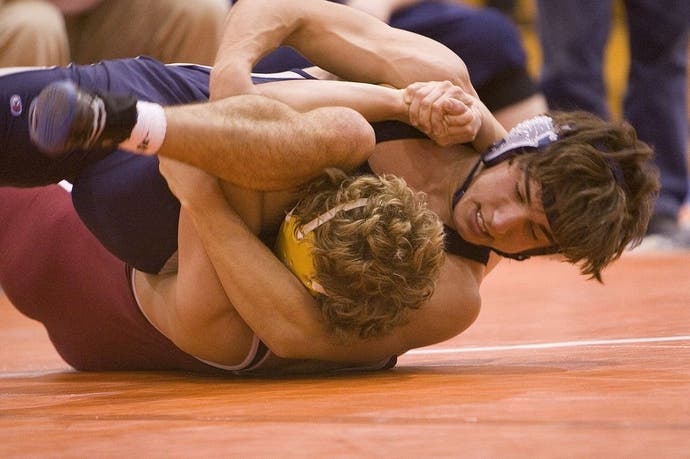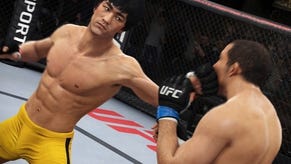Grappling is one of the oldest sports in the world - so why can't video games do it properly?
Choke artistry.
Pop quiz, video games fan: what was the first fighting game to feature counters, in-air reversals, special moves accessed by twirling the joystick, secret techniques that didn't appear in the instructions and a super attack that led to instant disqualification? Don't bother guessing, you're probably wrong: it was Brian Jacks' Uchi Mata, a judo game released on the ZX Spectrum and Commodore 64 which came out a full year before the original Street Fighter.
In an era where most games treated the player's frantic yanks on the joystick as nothing more than gentle suggestions, it was one of the most insanely complicated simulations ever released, with 16 throws possible from a variety of different positions and an ultimate one-throw KO (the uchi-mata itself, Jacks' signature hip throw) that took a flawless half-circle on the stick to execute. It had counters that relied on perfect timing. It had a 'grip meter.' It had a separate gauge to show the fighters' feet. And it's still one of the most faithful interpretations of Jigoro Kano's gentle art ever coded.
Grappling - which, for the sake of argument, we'll call any style of fighting that doesn't involve strikes or weapons - is difficult to translate into games. Incredibly difficult. I've been doing the real thing for nearly a decade - mainly Brazilian jiu-jitsu, otherwise known as the rolling-around-on-the-floor one, which I've got a purple belt in - but also judo, wrestling and MMA, where I've had four amateur fights and I still sometimes feel like I have no idea what's going on. So whenever a developer tells me that their whole studio's been practising for a couple of months so that they'll understand the moves - as EA Vancouver did for EA Sports UFC - it doesn't entirely fill me with confidence.

"There are so many nuances and techniques," says Jude Samuel, a black belt in Brazilian jiu-jitsu under the legendary Roger Gracie. "And then there's the feel of it. Even grapplers like to see people get knocked out, but grappling is one of those things that, to understand it properly, you have to do it. You can see striking and understand it - you can't feel exactly what it's like, but your brain can correlate to what's going on. With grappling, you have to feel it."
Grappling is unique as a sport for one very important, but not-very-obvious reason: the participants know what their opponent's up to before the spectators do. This is not true anywhere else: in football, every member of the crowd has a better view of play than any single player, and in cycling, a diehard fan watching at home can take in more of the action than whoever's leading the peloton, however furiously his team are bellowing into his earpiece. Even in mano-a-mano sports like boxing and tennis the playing field between participant and viewer is essentially level - whether or not they can interpret the participants' body language, their twitches and feints, their tiredness or lack of it, the crowd gets to see it at the same time as the person on the other side of the ring or the net.
"The sport as a whole is so insanely complex"
This isn't true in grappling. For complicated reasons to do with the speed of the somatosensory system versus the visual one - and less complicated ones like the fact that when two people are rolling around on the floor you can't always see where all their limbs are - any decent grappler can literally feel what's happening before even a well-informed onlooker can see it. A shift in weight, a tug on a limb, a bit more pressure on one specific point, a stronger grip - spectators just can't see these things. Tennis has a giant LCD screen telling everyone how fast that last serve was - science has yet to work a way of working out just how hard one man is squeezing another's carotid arteries during a live fight.
Then there's the sheer array of techniques to contend with. Judo, for instance, has 67 'officially' recognised throws, and although only a fraction of that number regularly appear in competition. But Brazilian jiujitsu - the style popularised by the UFC, which is focused on achieving superior positioning on the ground - has a near-infinite number of ways to combine its techniques. "You're never going to get that freedom of choice, because you'll always be restricted to the animations they've coded in," says MMA featherweight Ash Grimshaw. "It's never going to be you in there. It's always going to be this set character, doing this set of moves, but that's all there is. It can be good, and fun - I loved the original Pride game - but it's always going to be one-dimensional to a degree."
This is because the sport as a whole is so insanely complex. When you're first learning to do jiujitsu, you might know how a couple of basic submissions and a sweep, and you've got a vague idea of what the best position to be in is, but that's about it. As strategy goes, it's about as advanced as playing Street Fighter 4 after you've had a quick glance at your character's move list.

Sparring between beginners is a clumsy exchange of positions and the winner's usually the person who makes the least dumb mistakes. Maybe a couple of months later, you can spot a glaring error - somebody stretching their arms up in the air while they're mounted, say - and capitalise on it. While you're a beginner, this is like catching another beginner with Ryu's jumping heavy kick - there's a sudden, dizzying, 'How could they be so stupid?' moment, following by a quick, euphoric combination and (hopefully) a win. At this level, you still want to punch the air after every victory - aware that on some level it was bit of a fluke - but you don't, because there's decorum to observe.
As you get better, things change. Tapping out beginners who leave themselves open to an easy armlock is too simple, like playing against a Blanka-loving button-smasher. You need to find better opponents, ones who know that you never leave one arm inside someone's guard or lean too far forward in the mount. Against these opponents, you need to find ways to force errors, to make smaller mistakes into bigger ones. Like playing guessing games in Street Fighter - forcing your opponent to choose whether to defend a throw or an ultra when they get up, for instance - you might half-go for an armbar an opponent knowing they'll yank their elbow free, leaving themselves open to a triangle or an omoplata.
It's at this stage that you start to develop an actual 'game.' Unfortunately, there are people who are much, much better at this game than you, and when you're playing against them even a tiny, almost unnoticeable mistake means you're going to lose. Against these Kasparovs of strangulation, even putting one hand in the wrong position can be an unrecoverable error. This, of course, is difficult to simulate, because it's much harder to spot your avatar oh-so-briefly shift their weight the wrong way than notice them sail past you with a failed dragon punch.
That's not to say things haven't improved. The UFC Undisputed series made huge strides in grappling, using twirls on the joypad to mimic transitions from, say, 'guard' (where the fighter on the bottom has his legs wrapped around the one on top, allowing him to defend himself to a decent extent) to 'mount' (where one fighter sits on another, which is a terrible position for the man on the bottom). It also allowed reversals - where you could exploit the window of opportunity provided by the other person going for a move - and even allowed minimal 'feinting', via, say, just brushing the stick to mimic the start of a position.
But casual gamers complained that it was too complex, even though it barely scratched the surface of what's possible. "Movement options are just too complicated," says Rob Taylor, a BJJ black belt under multiple ADCC champion Braulio Estima. "There's no way to have a control system which simultaneously moves each limb independently."
This only becomes trickier when submissions - traditionally, the hardest bit for games to get right - are thrown in. To take the triangle choke - BJJ's most iconic move, in which one fighter wraps both legs around their opponent's head and one arm, cutting off the oxygen to their brain - as an example, there are about forty ways to set it up, and none of the ones involving simply throwing your legs up in the air will ever work on a reasonably good fighter. "In the games, you're going, okay, I'm doing the button press for the triangle, when realistically the triangle might not be there," says Grimshaw. "You need to block a specific punch, trap the arm, then respond to what the other guy does to tighten the whole thing up. More options to chain moves together would help, but it'll never entirely work."
"A realistic grappling game would be possible but, like the real sport or really high-level Street Fighter tournament play, a lot of it would be impenetrable to the casual observer"
Finally, there's the suspension-of-disbelief-smashing intrusiveness of every recent UFC title's submission minigames to consider. They sort of mimic the desperate struggle to tighten up or wriggle out of the choke/lock/crank or whatever - including the most recent one - but there's no denying they ruin the immersive feel of the games. And, really, they still don't mimic the conditions you'd normally get a submission in. In the real thing, submissions can happen in a flash - usually because one fighter's made a dreadful mistake.
"With the rear naked choke - it's not like you can throw punches, see someone move their hands away from their neck to defend their face, and choke them - it's never going to be like that," says Grimshaw. "I did like the way EA MMA forced you to manage your stamina so you wouldn't 'gas' while going for subs, though."
One answer might be to take the concept of Undisputed 2013's 'simulation' mode further, with a mode specifically designed for hardcore players willing to master the subtle nuances of looking out for tiny on-screen hints as to what their opponent's doing, just as the most hardcore of fighting game fans will scrutinise frame-rate data, learn which moves take priority over others, and spend days pressure-testing their training-room combinations before venturing online. A much more realistic grappling game would be possible but, like the real sport or really high-level Street Fighter tournament play, a lot of it would be impenetrable to the casual observer.
The real answer, then, is probably to not worry about it too much. One of the great beauties of grappling is that, since there are no violent concussive impacts involved, you can treat it almost like a video game in its own right - a game where you can lose decisively, suffer no ill-effects, and be in another match literally seconds later. It's a game with a near-infinite number of moves and combinations, an incredibly deep combat system, and thousands of players all ready for a fight. I play it all the time - but when I get home, I'll still crank up EA UFC. My chosen fighter? He's terrible at submissions, but he's got a hell of a left hook.
















